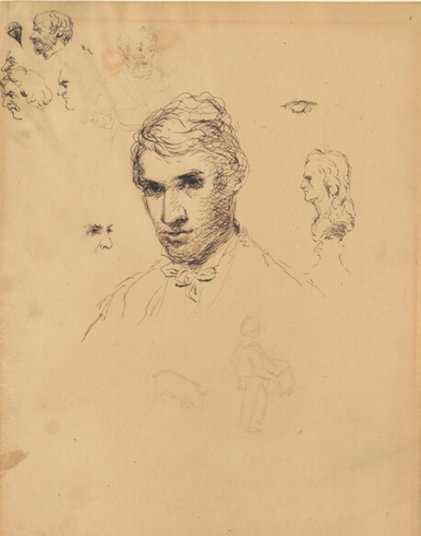Sanford Robinson Gifford – my daily art display
9 min read [ad_1]
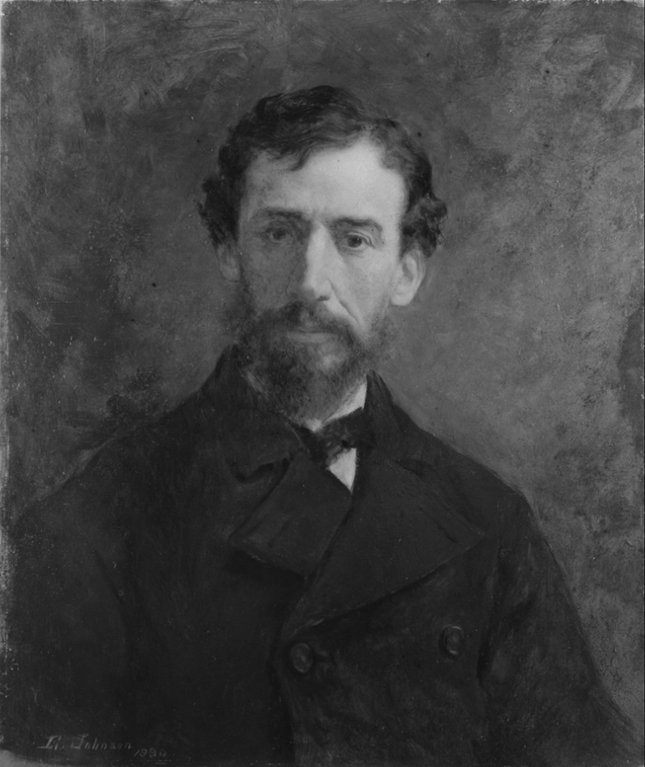
Today I am looking at an American painter, Sanford Robinson Gifford, who was a leading member of the second generation of Hudson River School artists. The artwork of the Hudson River School captured the rugged beauty of the American landscape and celebrated and venerated the heady era of manifest destiny. In 1845, newspaper editor John O’Sullivan coined the term Manifest Destiny, which was the belief that white Americans were divinely ordained to settle the entire continent of North America. The second generation of Hudson River School painters set out from the New York area to explore more far-flung regions of America. Their painting documented the westward expansion and the “land grab” which underpinned the concept of Manifest Destiny. During the Civil War, their majestic images shown in their paintings of an unspoiled West provided hope for post-war reconciliation and the promise of expanses of wild country, full of promise and lands which were unscarred by battle.
Sanford Robinson Gifford was born in Greenfield, New York 0n July 10th 1823. He was the fourth of the eleven children of Quaker ironmaker Elihu Gifford and his wife Eliza Robinson Starbuck. Most of his childhood was spent in Hudson, New York, a town on the banks of the upper reaches of the Hudson River, across from the Catskill Mountains. Following normal schooling, Gifford entered Brown University in 1842. He left college after completing two years, and moved to New York City in 1845 to study art. He studied drawing, perspective and anatomy under the British watercolourist and drawing-master, John Rubens Smith, who in 1806 had emigrated from London to the USA and set up successful drawing schools in Boston, New York and Philadelphia. He also attended drawing classes at the National Academy of Design and studied the human figure in anatomy classes at the Crosby Street Medical College.
In 1846 Gifford visited the Berkshire Hills and the Catskill Mountains, sketching en plein air. He thoroughly enjoyed his sketching trips, once writing to a friend:
“…”These studies together with the great admiration I felt for the works of [Thomas] Cole developed a strong interest in landscape art, and opened my eyes to a keener perception and more intelligent enjoyment of nature. Having once enjoyed the absolute freedom of the landscape painters’ life I was unable to return to portrait painting…”

The American Art Union bought and exhibited some of Gifford’s first landscape paintings in 1847. In 1851 he was elected an associate, and in 1854 an academician, of the National Academy of Design. He must have taken great pleasure in his landscape depictions as from that time on he concentrated on the landscape genre, becoming one of the finest artists of the Hudson River School. Gifford loved the freedom of the outdoors and travelled extensively to sketch landscapes which he would use later for future paintings. On his trips he would often write to his father recording his experiences. These letters home would, he said, serve the double purpose of letter and journal, and be an economy of time. He also asked his father to number the letters sequentially and keep them all together.

In the summer of 1855 Gifford crossed the Atlantic and visited England, Scotland and Paris. He then spent the winter of 1855 completing paintings from the numerous sketches he had made.

In the Autumn of 1856, he travelled to Italy and rented a studio in Rome and, during that winter he painted pictures of the surrounding area including Lake Nemi which he visited in October 1856. In a letter he described the scene:
“…We were high up above the lake. On one side in the foreground were some picturesque houses and ruined walls—a tall dark cypress, rising out of a rich mass of foliage, cut strongly against the lake, distance, and sky…”

By capturing scenes at sunset, Gifford was able to record the subtle effects of atmosphere and light that would become his trademark. Gifford was a true Luminist, a member of the Luminism art movement associated with many American landscape painters of the 1850’s to 1870’s Their artwork was characterized by effects of light in landscapes, through using aerial perspective, and concealing visible brushstrokes. The landscape art of the Luminist emphasized serenity and calmness. It focused on reflective water and soft, hazy skies but as part of often melodramatic, magnificent, oversized landscapes as the artist intended to capture the immenseness as they viewed their subject on location. An example of this Lumanism is his 1866 painting entitled A Home in the Wilderness. Gifford’s view of Mount Hayes in New Hampshire records human intrusion into a remote landscape. On the left riverbank a log cabin stands amid a recently cleared patch of land with several tree stumps, while figures in its doorway greet a man who has arrived with a canoe of supplies.

During the spring of 1857 whilst still in Rome, Gifford spent time with fellow American artists Worthington Whittredge, William H. Beard and Albert Bierstadt. Gifford and Bierstadt left Rome in May 1857 and set off on a walking tour of southern Italy. Gifford completed his European tour with visits to Innsbruck, Munich, Vienna, Prague, Dresden, Berlin and Paris, before returning to the United States at the end of the summer.
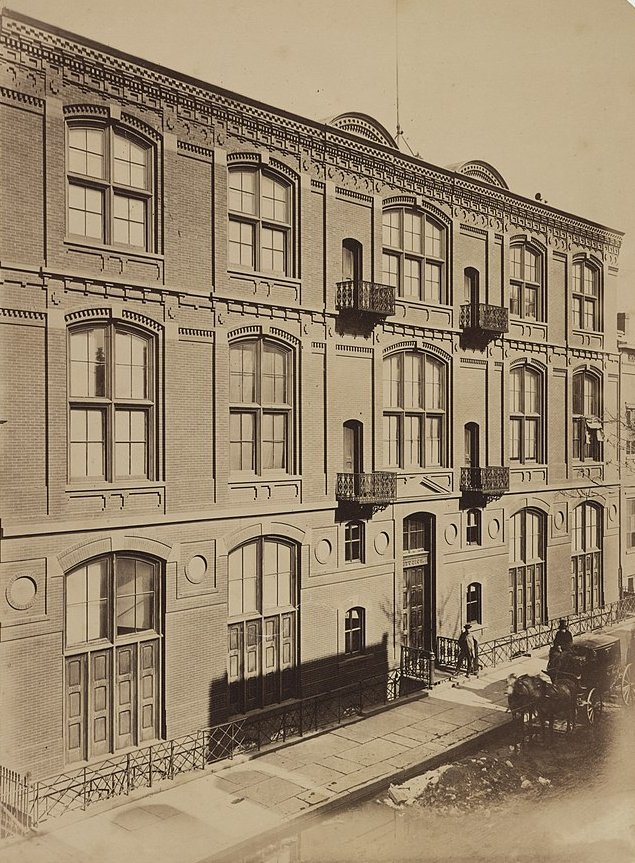
On his return Gifford rented studio Number 19 in the Tenth Street Studio Building in New York City. The Tenth Street Studio Building was constructed in New York City in 1857. It was situated at 51 West 10th Street between Fifth and Sixth Avenues in Manhattan and was the first modern facility designed solely to serve the needs of artists. It became the centre of the New York art world for the remainder of the 19th century. Gifford retained his studio until his death.

Over the next few years Gifford also made frequent summer trips to various north-eastern locales including the Catskills, the Adirondacks, the Green Mountains in Vermont, the White Mountains in New Hampshire, Maine and Nova Scotia.
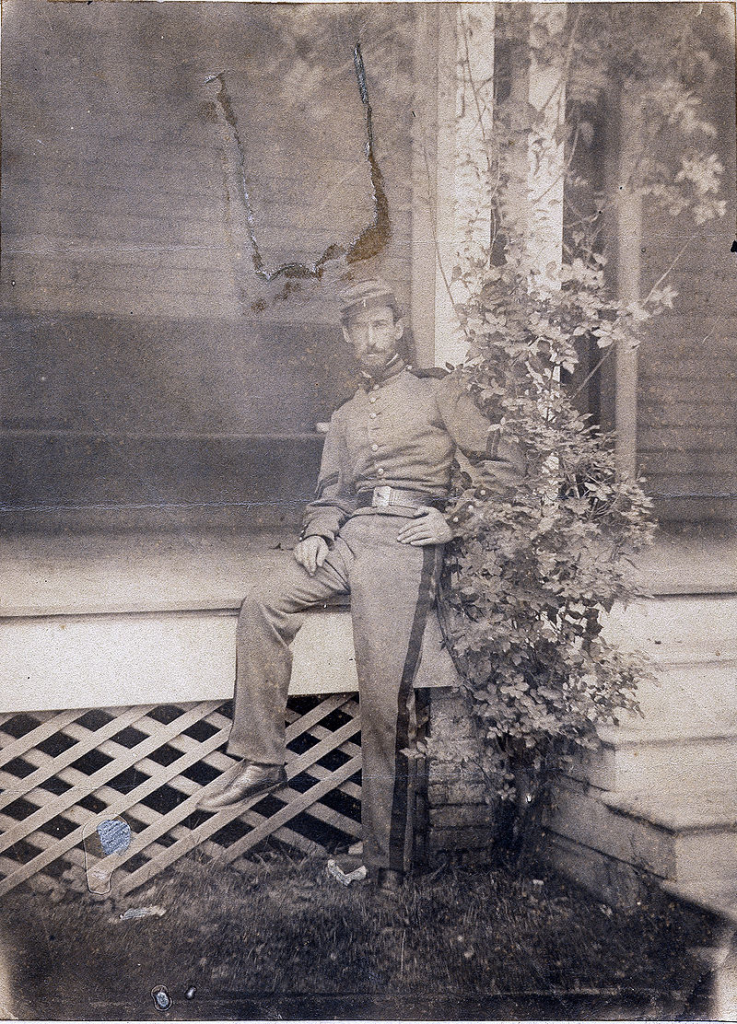
The American Civil War broke out in April 1861 and Gifford enlisted in New York’s Seventh Regiment and marched to the defence of Washington. Several paintings resulted from this experience, including his 1864 work entitled Sunday Morning in the Camp of the Seventh Regiment, near Frederick, Maryland, in July 1863 ,


Another was his night scene entitled Night Bivouac of the Seventh Regiment New York at Arlington Heights, Virginia which he completed in 1861.

In 1868 Gifford once again travelled to Europe, and again visited the English and French capitals. Whilst in Paris he met with a fellow American Hudson River painter, Jervis McEntee and his wife. McEntee was a to some extent a lesser-known figure of the 19th-century American art world but apart from his paintings, McEntee’s journals are an enduring legacy, documenting the life of a New York painter during and after the Gilded Age. From Paris Gifford spent the summer visiting the Alps and Sicily before wintering in Rome.

Gifford was always stimulated by the awe-inspiring Italian landscape and his painting Galleries of the Stelvio, Lake Como exudes a moment of pure artistic beauty. Gifford’s used shades of pastel blues and pinks to capture the hazy quality of a warm Italian summer afternoon. Look how the juxtaposition of light and shadow draws attention to the natural curve of the rock cliff exploited by and altered by man’s hand. The curve in the wall gives one the feeling of motion through the road tunnel and to the side of the road we see a couple looking over at the boats below and the still waters of the beautiful lake. Almost if we are in the tunnel\ we begin to feel the coolness of the tunnel in comparison to the area around the lake which is exposed to the sun.
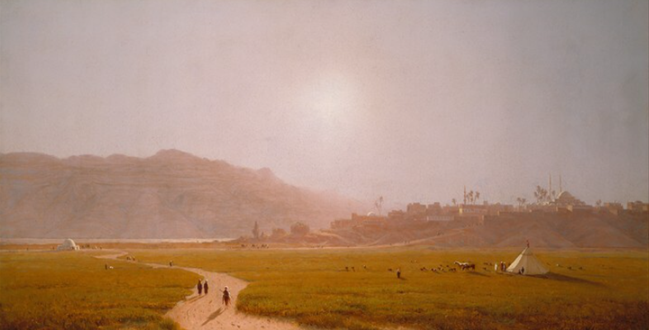
In 1869 Gifford set off on his travels once more. This time he journeyed to Egypt where he and some friends. He hired a boat and took a two-month voyage from Cairo down the Nile River to the first cataract . Although many American artists left their home shores, few ventured much further than the European Continent. Sanford Gifford was one of the very few who ventured further afield.
On March 4 he reached the village of Siout (Asyut), on the western bank of the Nile, and this was the starting point of a great caravan route running through the Libyan Desert to the Sudan. The town was well known for being picturesque and for its history, having been the capital of the thirteenth province of Upper Egypt during antiquity and the birthplace of Plotinus, the great Neoplatonic philosopher. Gifford was taken with the town and noted in his journal the reasons for depicting it in his painting. He wrote:
“…Looking westward, the town with its domes and minarets lay between us and the sun, bathed in a rich and beautiful atmosphere. Behind, on the right, were the yellow cliffs of the Libyan mts., running back into the tender grades of distance. Between us and the town were fields of grain, golden green with the transparent light. On the right was a tent with sheep and beautiful horses, the sunlight sparkling on a splendid white stallion. On the left the road ran in, with a fountain and figures of men and women and camels. The whole glowing and gleaming under the low sun…”
The painting, simply entitled Siout, Egypt, is one of Gifford’s finest works in which he depicted Egypt.
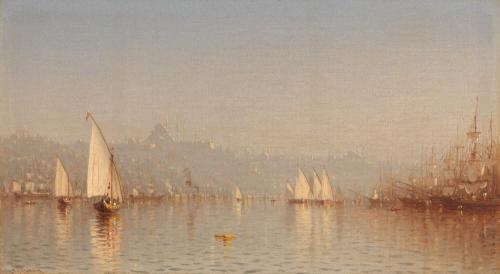
From Egypt, Gifford travelled to the Middle East with fellow artist, Alfred Craven, via the Suez Canal, where his itinerary included Syria, Jerusalem, Samaria, Damascus, Greece and Turkey. Gifford travelled to Constantinople in 1869 and he wrote about the time in his journal:
“…boats and costumes on the water on either side were all aglow with color, while through the purple haze of the distance flashed a thousand little golden lights from the windows of the Seraglio and the mosque of St. Sophia…”
Gifford final port of call was Venice which he reached in June 1869 and it was from here that he took a sea passage back to the United States at the beginning of September.

Sanford Gifford married Mary Cecilia Canfield in 1877, at age fifty-four.

I end this blog with my favourite painting by Gifford. It is his 1876 work entitled Autumn, a Wood Path. Gifford created several paintings depicting forest interiors, including this one set amid full autumnal blaze. The dense forest path is enclosed in a network of overarching trees which casts shadows on the rugged ground below, restricting sunlight to haphazard patches. A solitary hiker is visible in the distance.
Three years after his marriage, Gifford became ill while on a trip to Lake Superior and was brought back to New York where he was diagnosed as having contracted pneumonia following a bout of malarial fever. On August 29th, 1880, Gifford died in New York city, aged 57, and was buried at Hudson City Cemetery, Hudson, Columbia County, New York. His death was seen as a tragedy for American art. He was memorialized in 1880 by the publication of a series of addresses given at the Century Association and by a large retrospective exhibition at the Metropolitan Museum of Art in 1881. A compilation of a catalogue raisonné was published in 1881 and recorded that he had completed more than seven hundred paintings during his career.
The Rev. Dr. Bellows, who several times has officiated at the funerals of well-known American painters, delivered a touching and beautiful address in the Gifford mansion at Hudson. He spoke of Gifford’s love of his country, saying:
“…Patriotism, in the speaker’s opinion, was at one time a greater force in Gifford’s life than even love of Art; and his resolve to fight as a private soldier in the late war for the Union was greater in its influence upon the man, and in its possession of him, than even his devotion to his profession…”
[ad_2]
Source link

